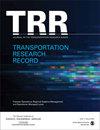基于移动设备位置数据的车辆体积估算大数据驱动框架
IF 1.8
4区 工程技术
Q3 ENGINEERING, CIVIL
引用次数: 0
摘要
车辆数量是交通信号控制、交通项目优先排序、道路养护规划等的关键指标和基本依据。量化车辆体积的传统方法依赖于人工计数、摄像机和有限数量的环路探测器。这些努力需要大量的劳动力和成本来进行扩展。研究人员和私营企业也在探索其他解决方案,比如探测车辆数据,尽管这种方法的渗透率仍然很低。近年来,随着移动传感器和移动网络技术的进步,移动设备位置数据量在人口及其移动性的时空覆盖方面急剧增长。本文提出了一个大数据驱动的框架,它可以摄取tb的MDLD,并在更大的地理区域和更大的样本量上估计车辆数量。提出的框架首先采用一系列基于云的计算算法来提取多模式轨迹和行程名单。然后应用一种可伸缩的地图匹配和路由算法来捕捉和路由车辆轨迹到道路网络。观察到的每段道路上的车辆计数被加权并根据地面真实控制总数进行校准,即年车辆行驶里程和年平均每日交通量。提议的框架将在2019年全年使用MDLD在马里兰州的全街道网络上实施。结果表明,所提出的框架产生了可靠的车辆体积,并且具有可转移性和泛化能力。本文章由计算机程序翻译,如有差异,请以英文原文为准。
Big-Data Driven Framework to Estimate Vehicle Volume Based on Mobile Device Location Data
Vehicle volume serves as a critical metric and the fundamental basis for traffic signal control, transportation project prioritization, road maintenance planning, and more. Traditional methods of quantifying vehicle volume rely on manual counting, video cameras, and loop detectors at a limited number of locations. These efforts require significant labor and cost for expansions. Researchers and private sector companies have also explored alternative solutions, such as probe vehicle data, although this still suffers from a low penetration rate. In recent years, along with the technological advancement in mobile sensors and mobile networks, the quantity of mobile device location data (MDLD) has been growing dramatically in spatiotemporal coverage of the population and its mobility. This paper presents a big-data driven framework that can ingest terabytes of MDLD and estimate vehicle volume over a larger geographical area with a larger sample size. The proposed framework first employs a series of cloud-based computational algorithms to extract multimodal trajectories and trip rosters. A scalable map matching and routing algorithm is then applied to snap and route vehicle trajectories to the roadway network. The observed vehicle counts on each roadway segment are weighted and calibrated against ground truth control totals, that is, annual vehicle-miles traveled and annual average daily traffic. The proposed framework is implemented on the all-street network in the State of Maryland using MDLD for the entire year of 2019. The results demonstrate that our proposed framework produces reliable vehicle volume and also its transferability and generalization ability.
求助全文
通过发布文献求助,成功后即可免费获取论文全文。
去求助
来源期刊

Transportation Research Record
工程技术-工程:土木
CiteScore
3.20
自引率
11.80%
发文量
918
审稿时长
4.2 months
期刊介绍:
Transportation Research Record: Journal of the Transportation Research Board is one of the most cited and prolific transportation journals in the world, offering unparalleled depth and breadth in the coverage of transportation-related topics. The TRR publishes approximately 70 issues annually of outstanding, peer-reviewed papers presenting research findings in policy, planning, administration, economics and financing, operations, construction, design, maintenance, safety, and more, for all modes of transportation. This site provides electronic access to a full compilation of papers since the 1996 series.
 求助内容:
求助内容: 应助结果提醒方式:
应助结果提醒方式:


